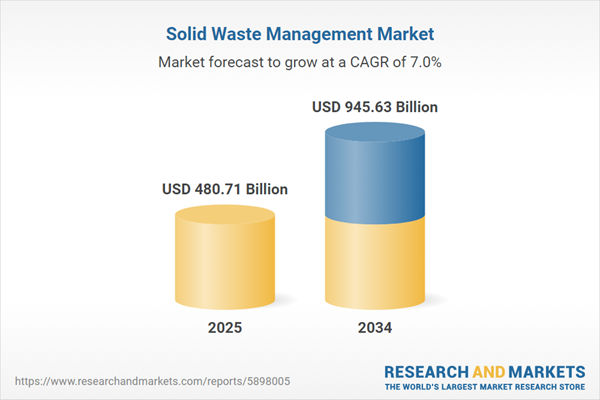Increasing Adoption of Innovative Solid Waste Management Solutions Augmenting the Market Growth
The Asia-Pacific is the leading market for solid waste management. China is the largest importer of waste, importing nearly 776,000 metric tons of recyclable plastic in 2016. However, the country has recently imposed a ban on 24 waste materials, which includes plastic waste. While it would severely affect major exporting countries like North America, Australia, and the European countries, it will also allow local players to compete with domestic players by developing and enhancing their recycling expertise. The solid waste management market in the Asia-Pacific is being driven by the rising adoption of integrated waste management and a shift away from the collect-and-dispose model, which is significantly reducing operational costs. Rising government regulations regarding sustainable waste disposal and growing technological adoption are also aiding the market growth in the region.With the growing population and surging income levels, the per-capita waste generation, especially in high-income countries, is significantly surging. This, in turn, is prompting the requirement for optimal solid waste management. As the awareness regarding the harmful consequences of poorly disposed and uncollected solid wastes is rising, the adoption of innovative solid waste management systems is significantly growing. The introduction of various favourable government initiatives to improve waste collection systems and develop innovative waste management strategies is also invigorating the solid waste management market. Technological advancements and innovations to enhance operational and cost efficiency while decreasing energy use in solid waste management are likely to further propel the market growth in the forecast period.
Market Segmentation
Solid waste management is referred to as the process of collection and treatment of solid wastes. It offers alternatives to recycle items that do not belong to garbage or trash. Through waste management, solid wastes can be transformed and used as a valuable resource. The industrialization has led to the creation of excessive solid waste, which harms the environment. It offers a remedy to create healthy surroundings.Based on end-uses, the market is segmented into:
- Pharmaceutical
- Personal Products
- Brewery and Distillery
- Food and Soft Drinks
The report also covers the regional markets of the product like:
- North America
- Europe
- Asia-Pacific
- Latin America
- Middle East and Africa
Growing Outsourcing of Solid Waste Management to Fuel the Market Growth
The global solid waste management market is driven by the absence of major suppliers' presence, which is directly operational across locations in a specific region, leading to subcontracting of services. The outsourcing of waste management services to a single supplier enables buyers to leverage synergies in several services founded on service provider capabilities, propelling the market further. The synergies are present in the collection, proper waste treatment, segregation, recycling, and disposal. The appropriate segregation of recyclable waste in the nascent period and disposing it to the appropriate supplier would save considerable costs involved in the disposing of wastes, invigorating the market growth. Due to substantial resale value, the suppliers charge less for recycling or disposing of recyclables. The buyers would be able to realize the operational benefits and cost efficiency and achieve economies of scale on engaging with a single waste management supplier, providing further impetus to the market’s expansion. The buyers will be able to re-examine their budgets on a regional scale, owing to the centralized procurement through a regional model, strengthening the market.The latest trends in the solid waste management market include an anaerobic breakdown of organic waste, drive for zero waste, innovative packaging, and using technology for waste separation, which are catalyzing the market growth. The anaerobic breakdown of organic waste involves airtight reactors, called anaerobic biogas digesters with micro-organisms, used to convert waste into biogas. The remnants can be used as fertilisers in agriculture. The converted biogas is used as energy and is moulded to fuel low-tech setups in the emerging countries. In Europe, 25% of organic waste is treated through anaerobic digestion. The use of biogas is a smart way to deal with solid waste without causing air pollution. It is also a source of renewable energy; thus, its use does not deplete or harm natural resources.
Another trend that is accelerating the market growth is innovative packaging. Many influential MNCs have started investing in innovative packaging to promote the reduction in the impact of wastes in their value chain and lowering costs at the same time, thus, enhancing the market growth. Lighter and stronger materials are preferred for packaging by companies, which makes their treatment easier. Technological advancements in solid waste management market to separate or sort the waste for suitable waste treatment, making the process easier, are further enhancing the market growth.
Key Players in the Global Market for Solid Waste Management
The report gives a detailed analysis of the following key players in the global solid waste management market, covering their competitive landscape, capacity, and latest developments like mergers, acquisitions, and investments, expansions of capacity, and plant turnarounds:- Veolia Group
- SUEZ Group
- URBASER S.A.
- FCC Environment (UK) Limited
- Harden Machinery Ltd.
- Geocycle
- REMONDIS SE & Co. KG
- DS Smith Plc
- Others
Table of Contents
Companies Mentioned
The key companies featured in this Solid Waste Management market report include:- Veolia Group
- SUEZ Group
- URBASER S.A.
- FCC Environment (UK) Limited
- Harden Machinery Ltd.
- Geocycle
- REMONDIS SE & Co. KG
- DS Smith Plc
Table Information
| Report Attribute | Details |
|---|---|
| No. of Pages | 164 |
| Published | August 2025 |
| Forecast Period | 2025 - 2034 |
| Estimated Market Value ( USD | $ 480.71 Billion |
| Forecasted Market Value ( USD | $ 945.63 Billion |
| Compound Annual Growth Rate | 7.0% |
| Regions Covered | Global |
| No. of Companies Mentioned | 9 |









